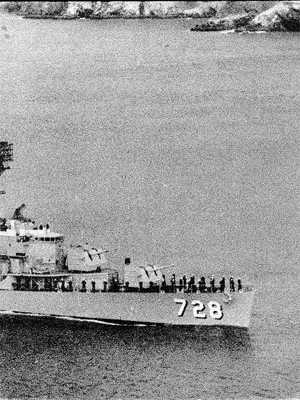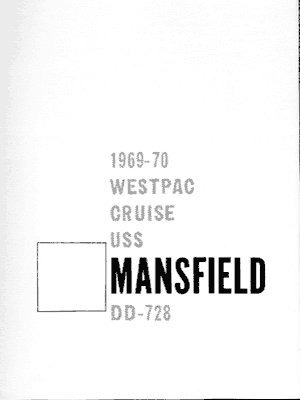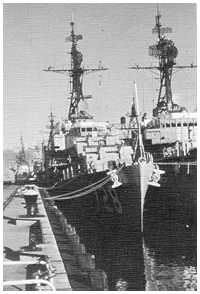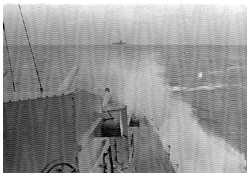 |
 |
 |
 |
The USS MANSFIELD is named in honor of Sgt. Duncan MANSFIELD, USMC, who volunteered and took part in an expedition under Lt. Stephen DECATUR, Jr., USN, aboard the ketch INTREPID. The expedition entered Tripoli Harbor on February 18, 1804 and destroyed the former U.S. Frigate PHILADELPHIA which had been captured.
The MANSFIELD was built in Bath Iron Works, Bath, Me., launched January 29, 1944, and commissioned on April 14 of that year. Immediately following commissioning, MANSFIELD joined the Pacific Fleet to build an admirable history of tradition and accomplishment encompassing combat duty in World War II, the Korean Way, and most recently, the Vietnam conflict.
World War II initiated MANSFIELD as a full-fledged combatant as she and sister ships of DESRON NINE and DESDIV-NINETY-ONE sand two Japanese merchantmen and damaged two others. Additionally, the capturing of the Japanese submarine I-400 greatly enhanced MANSFIELD's reputation as being a truly competent adversary in all phases of Naval engagement.
Although the war in the Pacific presented numerous hazards and threats of enemy attacks, MANSFIELD faced perhaps her greatest peril when a typhoon raked Adm. Halsey's Third Fleet, leaving hundreds of men dead and three destroyers lost. MANSFIELD weathered the storm; however she sustained major hull damage when her after stack was torn away by heavy winds and seas.
The amphibious campaigns of Iwo Jima and Okinawa once again saw the MANSFIELD lend support as her six 5'/38 guns softened the beach and assisted in paving the way to important American victories in the South Pacific.
June of 1950 again saw MANSFIELD and other ships of DESDIV NINETY-TWO dispatched for combat duty. This time, the scene of action was Korea. The squadron, at that time homeported in Sasebo, Japan, was deployed to Korean waters within 48 hours after the conflict began.
In December 1950, MANSFIELD, with units of DESDIV NINETY-ONE, steamed into Inchon Harbor in order to locate and eradicate shore batteries prior to an amphibious landing. The ensuing course of events earned the destroyers of DESDIV NINETY-ONE the Navy Unit Commendation and the nickname of the "sitting ducks division". The ships deliberately exposed themselves to enemy batteries so that they could complete their assigned mission.
The war in Korea was not all success for MANSFIELD. Upon her return from the States for repairs, the MANSFIELD struck a mine in Wonson Harbor while engaging enemy guns. As a result, the MANSFIELD now has a new bow forward of gunmount 51.
In February of 1960, MANSFIELD entered Long Beach Naval Shipyard for extensive modernization which gave the ship wider range of capabilities in antisubmarine warfare. The program, Fleet Rehabilitation and Modernization (FRAM) included the installation of the Drone Anti-Submarine Helicopter (DASH) System, Variable Depth Sonar, improved surface and air radars, and homing torpedoes. This overhaul added many years of useful service to the veteran destroyer.
The years between 1960 and 1965 were less exciting than those which lay behind and those which were ahead. In 1965 the United States became extensively active in Vietnam and it wasn't long before the USS MANSFIELD was lending her support to Allied operations.
 The USS MANSFIELD, along with DESRON NINE, shifted homeport to Yokosuka, Japan in June of 1966. being homeported much closer to the area of conflict most other destroyers, led to establishing MANSFIELD and DESRON NINE as the "Work Horses of the Western Pacific" for the next two years.
The USS MANSFIELD, along with DESRON NINE, shifted homeport to Yokosuka, Japan in June of 1966. being homeported much closer to the area of conflict most other destroyers, led to establishing MANSFIELD and DESRON NINE as the "Work Horses of the Western Pacific" for the next two years.
On October 25, 1966, while patrolling the coast of North VIetnam in search of Waterborne logistics craft carrying supplies to hostile forces in South Vietnam, MANSFIELD , accompanied by a second U.S. destroyer USS HANSON, came under fire from NVN coastal defense sites. MANSFIELD responded to the attack with her guns and continued to fire until the hostile fire ceased. As a result of this action, Operation Sea Dragon was initiated to project naval gunfire and coastal plains for logistic traffic.
On September 25, 1967, eleven months to the day after opening Sea Dragon, MANSFIELD sustained one hit from North Vietnam coastal defense sites near Dong Hoi killing one man and seriously wounding two others. After completing repairs, MANSFIELD continued supporting Allied Forces in Vietnam.
While in the Tonkin Gulf, MANSFIELD also served as plane guard in air operations conducted by the aircraft carriers CORAL SEA, and USS BON HOMME RICHARD; however, the vast majority of MANSFIELD's time was spent in Sea Dragon operations, and in South Vietnam, providing Naval Gunfire Support (NGFS). While serving in Vietnam, MANSFIELD established the undisputed record of firing more rounds of five inch projectiles thatn any other destroyer type ship.
The Viet Cong had little opportunity to relax the 24 months that MANSFIELD was homeported in Yokosuka, Japan; however on a few occasions, MANSFIELD ceased bombarding the Vietnam coast long enough for a quick trip home to engage in a different facet of naval operations.
In 1967, while in Yokosuka, MANSFIELD underwent training as a recovery ship for the Gemini space craft. Again in 1968, the MANSFIELD was enjoined to render her professional and versatile capabilities by training ship for the Apollo missions.
In June of 1968 MANSFIELD departed Japan enroute to Long Beach, California, which would be the ship's next homeport. The trip provided a well-deserved reward for the ship and the crew since the itinerary included visits to Australia and New Zealand.
In October 1968, MANSFIELD entered Long Beach naval Shipyard for a major overhaul period lasting until January 11, 1969. Upon departing from the shipyard, MANSFIELD celebrated her 25th birthday on January 29 and made ready for many more years of proud service.
On February 3, command of the MANSFIELD was transferred to Commander Paul L. ANDERSON, USN, by Commander Jack R. GRIFFIN, USN, in formal ceremonies on board MANSFIELD. The ship then departed Long Beach for a period of Refresher Training in San Diego.
From the completion of refresher training at the end of March, until her deployment to the Western Pacific in September, the MANSFIELD participated in numerous fleet exercises in preparation for her movement overseas. MANSFIELD also participated in three major community celebrations. The ship visited Eureka, California, for the Rhododendron Festival; Portland, Oregon for the Rose Festival, and Seattle, Washington for the Seafair.
On September 26, 1969, after one year in Long Beach, the MANSFIELD again set her course for the Western Pacific and duty with the United States Seventh Fleet.
This book is the story of the next six months in the life of the Pacific Fleet destroyer, USS MANSFIELD.